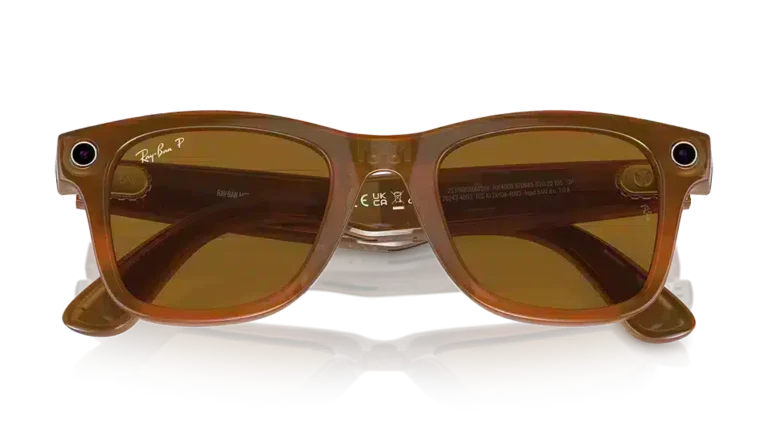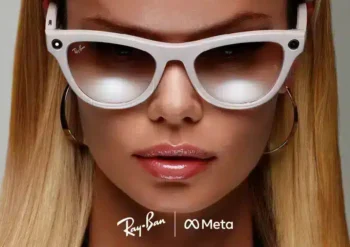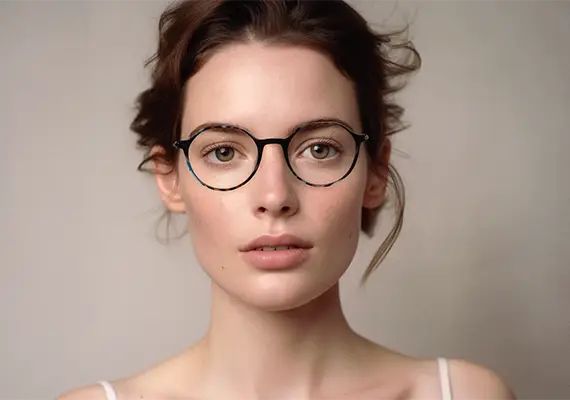
Smart glasses 2025 are emerging as a must-have tech accessory, redefining how we interact with the digital world. What if your glasses became your new screen, your personal assistant, your real-time translator? Thanks to the latest breakthroughs in augmented reality, artificial intelligence, and ultra-thin immersive displays, smart glasses are transforming our everyday lives—while maintaining a sleek and discreet design.
But what technologies are driving this revolution? Which models are leading the market in 2025? And how have these glasses become everyday tools we can’t live without?
Augmented reality navigation, instant communication, multimedia content capture… these glasses are no longer just a gadget—they’ve become a tool with advanced functionalities. The market is seeing exponential growth: according to a study published on pmarketresearch.com, it could reach €20 billion by 2025, with adoption accelerating rapidly. In 2022 alone, there were already over one billion connected devices worldwide, including 135 million smartwatches, highlighting the rise of wearable technology. Smart glasses are no longer a trend—they’re a lasting, structural evolution.
Let’s take a closer look at this transformation that’s redefining how we see and interact with the world.
Smart glasses 2025 are equipped with cutting-edge technologies like ultra-thin waveguide lenses and high-resolution micro-OLED displays. These innovations ensure smooth, crisp imagery projected directly into the user’s field of view. Some models also feature adaptive electrochromic lenses, enhancing the experience by adjusting to ambient light conditions.
Built-in AI transforms smart glasses into true personal assistants. Key features include:
Real-time translation with subtitles displayed directly on the lenses.
Object recognition and instant contextual information.
Advanced voice control for seamless navigation without needing a smartphone.
Personalized display based on the user’s environment and preferences.
The latest generation of smart glasses 2025 embraces lightweight materials like carbon fiber, optimized batteries, and fast-charging technology. Some models offer up to 8 hours of battery life in augmented reality mode and include modular external batteries to extend usage even further.
The smart glasses market in 2025 is more diverse and competitive than ever, with models tailored to meet a wide range of needs. Whether it’s for augmented reality, smart audio, video capture, or professional productivity, manufacturers are constantly pushing the limits of wearable tech.
Here’s a selection of the best smart glasses of the year, organized by category.
| Use Case | Key Features | Recommended Models |
|---|---|---|
| Augmented Reality (AR) / Gaming | High-resolution display, wide field of view, lightweight | XReal Air 2 Pro, Even Realities G1, Microsoft HoloLens 2 |
| Calls and Voice Assistants | Directional speakers, AI compatibility, long battery life | Amazon Echo Frames, Bose Frames Tempo |
| Video Capture and Social Media | High-definition camera, social media integration | Ray-Ban Meta Smart Glasses, Snap Spectacles 4 |
| Professional Use | PC/smartphone integration, advanced AR interaction | Lenovo ThinkReality A3, Microsoft HoloLens 2, Vuzix Blade 2 |
AR smart glasses allow digital information to be overlaid directly onto the real world. They’re especially valuable for professionals, gaming enthusiasts, and anyone seeking a next-level immersive experience.
Price: ~€449
Highlights:
1080p Micro-OLED displays for crisp and fluid visuals
130-inch virtual screen for gaming and streaming
Adaptive electrochromic lenses (immersion/transparency mode)
Use Cases: Multimedia viewing, gaming, secondary computer display
Price: ~€1,200
Highlights:
Transparent waveguide lenses for contextual information overlay
8 MP camera with remote assistance and shared viewing
Compatible with Microsoft Teams, Zoom, and professional tools
Use Cases: Industry, logistics, healthcare, technical support
The Even Realities G1 blends elegant design, lightweight materials (magnesium alloy, hypoallergenic silicone), and advanced digital functionality. The proprietary HAOS™ (Holistic Adaptive Optical System) projects real-time data into the user’s field of view, offering:
Real-time translation: Instant conversion of conversations in 13 languages
GPS navigation (beta): Step-by-step directions, still in development
AI Teleprompter: Scrolls scripts or notes in sync with the user’s voice
QuickNotes: Voice note capture with automatic text transcription for later access
Available with or without prescription lenses, and includes an optional solar clip-on.
Price: ~€699
Highlights:
4K Micro-LED display with wide field of view
Advanced eye-tracking and gesture control
Biometric sensors for health and activity monitoring
Compatible with iOS, Android, and PC
Use Cases: Immersive AR experiences, productivity, advanced gaming
Even G2 Launch Teased for November 12 on YouTube
These smart glasses focus on directional audio and voice assistant integration. They’re perfect for users who want to listen to music, take calls, or interact with a voice assistant—without traditional earbuds.
Price: ~€250
Highlights:
Full Alexa integration for hands-free voice control
Directional speakers built into the arms for discreet listening
Up to 14 hours of mixed-use battery life
Use Cases: Calls, voice assistant, music, and podcasts
Price: ~€280
Highlights:
Bose sound quality for immersive audio
Sporty, water- and dust-resistant design (IPX4 rating)
Interchangeable lenses (tinted or clear)
Use Cases: Sports, music on the go, audio navigation
Content creators are on the lookout for smart glasses that can record live video while delivering high-quality footagetailored for social media platforms.
Born from a collaboration between Meta Platforms, Inc. and EssilorLuxottica, the Ray-Ban Meta Smart Glassesdominate the market. Their cutting-edge technology is built into a signature frame, offering hands-free calls, photo and video capture, and music streaming.
Price: ~€329
Highlights:
12 MP camera for Full HD video recording
“Hey Meta” voice assistant, compatible with Instagram and Facebook
Classic Ray-Ban design (Wayfarer, Round) with optional prescription lenses

Price: ~€380
Highlights:
Dual AR-ready cameras for adding augmented reality effects
Interactive features tailored for TikTok and Snapchat
Compatible with Snap Lens Studio for content creators
Use Cases: Immersive content creation, first-person video recording
More and more businesses are adopting smart glasses to enhance communication, training, and task management in remote and on-site environments.
Price: ~€3,500
Highlights:
Advanced AR interface with gesture-based interaction
Integration with Dynamics 365, ideal for industry and healthcare
Expanded field of view for enhanced immersion
Use Cases: Industrial maintenance, training, 3D data visualization
Price: ~€1,499
Highlights:
Virtual display with up to 5 simultaneous monitors
Compatible with PC and smartphone for an augmented workspace
Lightweight and ergonomic for extended use
Use Cases: Remote work, mobile productivity, IT security
For Augmented Reality: XReal Air 2 Pro is ideal for entertainment, while Vuzix Blade 2 and Even Realities G1offer more advanced AR experiences.
For Smart Audio: Amazon Echo Frames are perfect for voice assistant users, and Bose Frames deliver premium sound for athletes and active lifestyles.
For Video Capture: Ray-Ban Meta Smart Glasses are the most popular among content creators, while Snap Spectacles take AR-based storytelling to the next level.
For Work and Productivity: Lenovo ThinkReality A3 is a great mobile productivity tool, while HoloLens 2remains the go-to choice for enterprise-grade solutions.
| Model | Price | Main Features | Use Cases |
|---|---|---|---|
| XReal Air 2 Pro | €449 | Micro-OLED display, immersion/transparency mode | Streaming, gaming, virtual display |
| Vuzix Blade 2 | €1,200 | Pro-grade AR, 8MP camera, waveguide lenses | Remote assistance, industrial use |
| Even Realities G1 | €699 | 4K Micro-LED, eye tracking, gesture controls | Immersive AR, productivity, advanced gaming |
| Amazon Echo Frames (3rd Gen) | €250 | Alexa voice assistant, directional audio | Calls, music, voice control |
| Bose Frames Tempo | €280 | Premium Bose sound, IPX4 rating, swappable lenses | Sports, outdoor music |
| Ray-Ban Meta Smart Glasses | €329 | 12MP camera, instant social media sharing | Vlogging, hands-free calls |
| Snap Spectacles 4 | €380 | AR video capture, dual camera, interactive filters | Immersive content creation |
| Microsoft HoloLens 2 | €3,500 | Advanced AR interface, gesture interaction | Industry, healthcare, training |
| Lenovo ThinkReality A3 | €1,499 | Virtual desktop, PC & smartphone connection | Mobile productivity |
The smart glasses market continues to evolve, with several highly anticipated models expected to redefine the industry. Samsung, Apple, Meta, and Google are all actively developing their next-gen smart glasses, promising major innovations in multimedia capture, artificial intelligence, and augmented reality.
Samsung is preparing to launch its first pair of smart glasses, set to expand the Galaxy ecosystem. According to early leaks, the focus will be more on voice interaction and content capture than immersive AR display.
Expected features include:
A Qualcomm AR1 processor, optimized for AR and AI tasks
A Sony IMX681 12 MP camera for high-quality photo and video capture
Ultra-lightweight design (50g) for all-day comfort
Integration of Google’s Gemini AI, enabling advanced gesture recognition and smart interactions
Samsung is rumored to unveil a preview of these glasses during its Galaxy Unpacked event in January 2025, with a release planned for summer 2025.
Meanwhile, other tech giants are also making strides in the smart glasses arena:
Apple is reportedly working on a lighter, more accessible version of the Apple Vision Pro, designed for everyday use.
Meta and Ray-Ban could expand their lineup with smart glasses featuring a mini-display, capable of showing real-time notifications and updates.
Google is officially making a comeback in the XR space with Android XR, a dedicated operating system for extended reality. Unveiled in partnership with Samsung and Qualcomm, this project could represent the next evolution beyond Google Glass, with native integration of Gemini AI in a future generation of smart glasses.
Despite increasingly advanced innovations, several key challenges still slow the mainstream adoption of smart glasses.
Smart glasses, especially high-end models like the Microsoft HoloLens 2 or Even Realities G1, remain expensive. While some brands offer more affordable alternatives—such as Amazon Echo Frames or Ray-Ban Meta Smart Glasses—price is still a major barrier for the average consumer.
Battery life is a critical issue for smart glasses. Unlike smartphones, which typically last a full day, most AR glasses offer only 3 to 8 hours of battery life, depending on usage. This technical limitation makes extended use difficult, especially for professionals and content creators.
The integration of cameras and microphones raises concerns about data privacy and passive surveillance. The backlash over Google Glass in 2013 remains a cautionary tale, pushing manufacturers to implement stronger security and transparency measures to reassure users.
While early smart glasses were often bulky and awkward, new generations prioritize a sleeker and lighter design. Brands like Ray-Ban, Bose, and Samsung now offer models that look like regular eyewear—but some users still question their comfort for extended wear.
Despite these challenges, several technological advances are accelerating the adoption of smart glasses, especially thanks to artificial intelligence, mobile connectivity, and augmented reality.
The rise of embedded AI is transforming smart glasses into true personal assistants. With tools like Google Gemini(Samsung Galaxy AI), these devices now offer instant translation, object recognition, and advanced voice interactions.
Initiatives from Meta, Apple, and Microsoft in the metaverse and augmented reality space are opening new doors. Smart glasses are no longer just gadgets—they’re becoming immersive interfaces that enable intuitive interaction with digital environments.
Smart glasses are increasingly synchronized with smartphones, smartwatches, and voice assistants. Companies like Apple, Samsung, and Google are developing models that communicate in real time with other devices, helping streamline adoption.
According to a study published on pmarketresearch.com, the smart glasses market could reach €20 billion by 2025, with rising adoption in sectors like healthcare, gaming, sports, and remote work.
The smart glasses market in 2025 is shaped by three main types of players:
Apple: After launching the Vision Pro, Apple is reportedly developing a more compact and affordable version, aimed at mainstream consumers.
Samsung: With its Galaxy AI Glasses, the Korean brand is betting on deep integration with Android and the broader Galaxy ecosystem.
Meta: In partnership with Ray-Ban, Meta continues to develop smart glasses focused on social interaction and multimedia capture.
Microsoft: With the HoloLens 2, Microsoft remains a leader in the professional AR segment.
Even Realities: This fast-rising startup has made a name with its G1 smart glasses, combining 4K display, eye tracking, and advanced ergonomics.
XReal: With the XReal Air 2 Pro, the company targets a more mobile and accessible approach to AR.
Ray-Ban (with Meta): Focuses on timeless design smart glasses, seamlessly integrating cameras and microphones.
Bose: Specializes in audio smart glasses, offering a sleek alternative to wireless earbuds.
EssilorLuxottica: Investing heavily in connected optics, integrating cutting-edge tech into prescription lenses.

Smart glasses are evolving rapidly and could reach adoption rates similar to smartwatches in the coming years.
More affordable pricing: Entry-level models under €500 are becoming increasingly common, making the technology more accessible.
Improved battery life: High-efficiency batteries will allow for all-day use without frequent recharging.
Innovative features: The integration of high-definition AR and AI will turn smart glasses into truly essential everyday tools.
By 2030, smart glasses could begin to replace smartphone screens in certain scenarios. With the rise of voice and gesture-based interfaces, they have the potential to become the primary way we interact with digital environments—making our interactions more natural and seamless.
While some challenges remain—such as price, battery life, and privacy—smart glasses are steadily becoming a new daily essential. Thanks to advances in AI, AR, and mobile connectivity, they are becoming more deeply integrated into our habits and routines, with growth expected to continue in the years ahead.
The rise of major players like Apple, Samsung, Meta, and Microsoft, alongside innovative newcomers like Even Realities, is shaping a more mature and diversified smart glasses ecosystem.
The future of smart glasses is unfolding now. The question is: will they become as indispensable as our smartphones?
With the rise of smart glasses, choosing the right model depends on several factors: usage, battery life, comfort, price, and compatibility with your tech ecosystem. Here are the key aspects to consider:
| Criteria | Recommendation |
|---|---|
| Ideal weight | Under 50g for daily use |
| Adjustability | Flexible frame, adjustable arms |
| Prescription lenses | Check compatibility with corrective lenses |
| Type of Smart Glasses | Average Battery Life | Connectivity |
|---|---|---|
| Smart audio glasses | 8–14 hours | Bluetooth, voice assistant |
| Consumer AR glasses | 3–6 hours | Wi-Fi, 5G, cloud computing |
| Professional AR glasses | 2–4 hours | PC, enterprise network |
| Category | Average Price | Example Models |
|---|---|---|
| Entry-level | €200–400 | Amazon Echo Frames, Bose Frames Tempo |
| Mid-range | €400–900 | XReal Air 2 Pro, Ray-Ban Meta, Even Realities G1 |
| High-end (AR/Pro) | €1,200–3,500 | Microsoft HoloLens 2, Lenovo A3, Vuzix Blade 2 |
| Main Need | Recommended Model |
|---|---|
| Immersive Augmented Reality | XReal Air 2 Pro, Even Realities G1 |
| Smart Audio Glasses | Bose Frames, Amazon Echo Frames |
| Content Creation | Ray-Ban Meta Smart Glasses, Snap Spectacles 4 |
| Professional Use | Lenovo ThinkReality A3, Microsoft HoloLens 2 |
With a growing market and increasingly affordable options, smart glasses are becoming a real alternative to smartphones for many use cases. Choosing a model based on your needs helps optimize your investment and take full advantage of the latest innovations.
Further reading :
Smart glasses are tech accessories equipped with intelligent features. They allow users to navigate in augmented reality, access a voice assistant, listen to music, make calls, take photos and videos, and display real-time information.
Standard smart glasses, such as the Ray-Ban Meta Smart Glasses or Amazon Echo Frames, focus on audio and video capture without visual overlays. They enable voice assistant interaction and notification access.
AR glasses, like the XReal Air 2 Pro, Even Realities G1, or Microsoft HoloLens 2, display digital elements directly in the user’s field of view. They’re used for gaming, productivity, or professional tasks.
Prices vary depending on the technology. Entry-level smart audio glasses range from €200 to €400. Mid-range models with video and light AR features cost between €400 and €900. Advanced AR glasses for professionals can reach up to €3,500.
Yes, most smart glasses work with both iOS and Android, though some are optimized for specific ecosystems. For example:
Ray-Ban Meta Smart Glasses require the Meta View app, compatible with Android 8.1+ and iOS 13+. They work with Samsung smartphones.
XReal Air 2 Pro glasses are compatible with Android, iOS, PC, and Mac, but may require an adapter.
Microsoft HoloLens 2 is designed for use with Windows and needs advanced network integration.
Battery life varies by model and usage.
Smart audio glasses like Amazon Echo Frames offer up to 14 hours.
AR glasses usually last between 3 and 6 hours.
Pro-level models like Microsoft HoloLens 2 often provide 2–4 hours but support external battery packs.
Yes, some brands offer prescription-ready versions or the ability to fit custom lenses. Ray-Ban Meta Smart Glasses and Lenovo ThinkReality A3 support this option. Other models may require optical clips or adjustments by an optician.
Some functions (like taking photos or listening to downloaded music) can work offline. However, features like voice assistants, AR overlays, real-time updates, and cloud computing require Wi-Fi, Bluetooth, or 5G connectivity.
Privacy and security are major concerns. Glasses with cameras and microphones must comply with privacy standards. Many models include recording indicators (like LED lights), and manufacturers now focus on transparent data policies.
Smart glasses are available on official brand websites (Samsung, Apple, Meta, XReal, Microsoft), in tech retail stores (Apple Store, Samsung Store, Fnac, Boulanger), and on major e-commerce platforms like Amazon, Cdiscount, and Rakuten.
It depends on your needs:
For immersive AR: XReal Air 2 Pro, Even Realities G1
For smart audio experiences: Bose Frames, Amazon Echo Frames
For video capture and social sharing: Ray-Ban Meta Smart Glasses, Snap Spectacles 4
For professional use with advanced AR: Microsoft HoloLens 2, Lenovo ThinkReality A3
Receive exclusive updates on the latest in the world of eyewear, our favorite selections, and unique offers reserved just for our subscribers. Join the Parisée community and elevate your style today!

Photo : Lumiprod